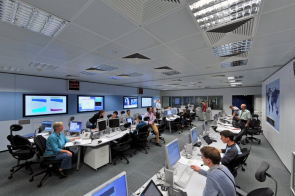INTEGRAL manoeuvres for the future
23 January 2015
Since 2002, ESA's Integral spacecraft has been observing some of the most violent events in the Universe, including gamma-ray bursts and black holes. While it still has years of life ahead, its fuel will certainly run out one day. |
| The INTEGRAL spacecraft. Credit: ESA |
Integral, one of ESA's longest-serving and most successful space observatories, has begun a series of four thruster burns carefully designed to balance its scientific life with a safe reentry in 2029.
That seems far off, but detailed planning and teamwork now will ensure that the satellite's eventual entry into the atmosphere will meet the Agency's guidelines for minimising space debris.
Making these disposal manoeuvres so early will also minimises fuel usage, allowing ESA to exploit the valuable satellite's lifetime to the fullest.
This is the first time that a spacecraft's orbit is being adjusted, after 12 years in space, to achieve a safe reentry 15 years in the future, while maximising valuable science return for the subsequent seven to eight years.
"Our four burns will use about half of the estimated 96 kg of fuel available," says Richard Southworth, spacecraft operations manager at ESA's Space Operations Centre, ESOC, in Darmstadt, Germany.
"This will influence how Integral's orbit evolves, so that even after we run out of propellant we will still have a safe reentry in February 2029 as a result of natural orbit decay.
"No further manoeuvres are required between now and then and Integral can continue to operate."
Debris mitigation
 |
| Protected orbital regions. Credit: CNES |
The latest ESA debris guidelines require that a satellite must be disposed of in such a way that it poses no risk to other satellites in protected orbital regions for more than 25 years.
Although Integral's early launch date, in 2002, means it is not required to stick to the guidelines, they were followed for planning the disposal.
"We have done a great deal of modelling for Integral's reentry in 2029," says Klaus Merz of ESA's Space Debris Office.
"We're confident that this month's manoeuvres will put it on track for a future safe reentry at latitudes in the far south, reducing risk far below guideline levels."
Without these firings, the fuel supply would run out in perhaps 12-16 more years, after other essentials such as power end Integral's working life. But the satellite would not reenter for up to 200 years, which would present a hazard to other missions.
Manoeuvring in space
The first of the four burns was performed on 12-13 January, and ran for 16 minutes.
It delivered a small change in orbital velocity, and hence size and shape of the orbit, so that ESA's Perth, Australia, ground tracking station would become usable for the satellite for all future manoeuvres.
This is important because it allows the Integral team to execute subsequent firings exactly at perigee – the point of closest approach to Earth's surface – which is the optimum point in its orbit to execute manoeuvres, leading to the most efficient use of fuel.
The second and largest burn is set for Saturday, 24 January, and will run for about 32 minutes to provide about half of the overall required change in velocity.
The third manoeuvre is planned for 4 February, followed by a possible fourth on 12 February to trim the orbit in order to provide favourable tracking coverage for the rest of the mission from ESA's Kiruna ground station in Sweden.
Teamwork delivers results
 |
| Space navigators at work. Credit: ESA/J. Mai |
Developing the complex plan has taken years of teamwork by the mission operations and science operations teams, but it will set Integral onto a sustainable course for the rest of its mission.
"At first glance, it looked like the goals of space debris mitigation and maximising science were incompatible considering the limited amount of fuel available," explained Claudia Dietze and Gerald Ziegler, flight dynamics specialists working on Integral at ESOC.
"However, after detailed analysis, a sequence was developed that meets both goals. Moreover, additional considerations of attitude constraints and ground station coverage had to be taken into account, making it a highly interesting and challenging undertaking."
With the burns complete, Integral will continue scientific observations until its fuel runs out in the early 2020s.
The normal degradation of the solar panels by radiation will begin to limit observations anyway until, at some point probably in the mid-2020s, science operations would need to stop regardless of fuel.
"However, we are also looking into ways to reduce routine fuel usage by applying techniques developed for other missions, such as our sister satellite, XMM-Newton," says Richard Southworth.
Sustainable future
| INTEGRAL's reentry animation. Credit: HTG (Click here for further details and a larger version of this video.) |
"This is a robust, doable, safe and complete plan," says Peter Kretschmar, Integral's mission manager.
"It's allowing us to maximise the precious scientific return from this satellite, while fully meeting end-of-life and debris mitigation guidelines," adds Erik Kuulkers, Integral's project scientist.
The mission celebrated its 10th anniversary in orbit in 2012, and is currently extended until December 2016.
Integral enables scientists to study our Universe at gamma-ray wavelengths, and it has discovered amazing objects including one of the fastest spinning neutron stars as well as gamma-rays from a supernova.
Editor's note: manoeuvre dates mentioned here are all subject to change through operational considerations. Follow ESA's Rocket Science blog for a detailed timeline and Twitter for live updates.
This article was originally published on ESA's Operations Portal
